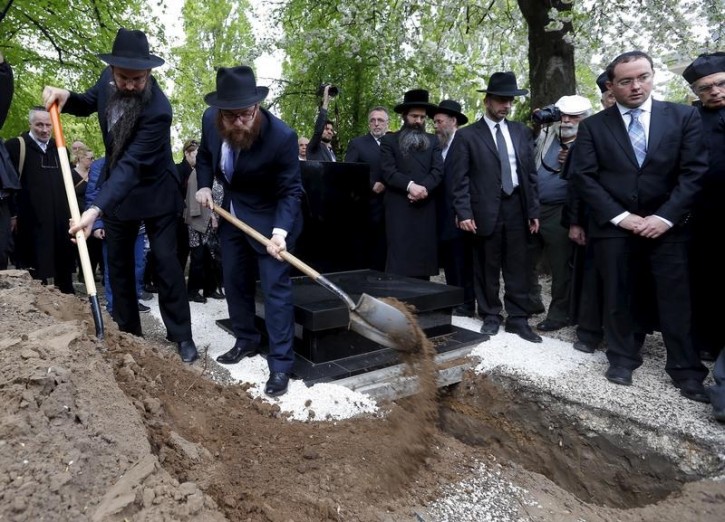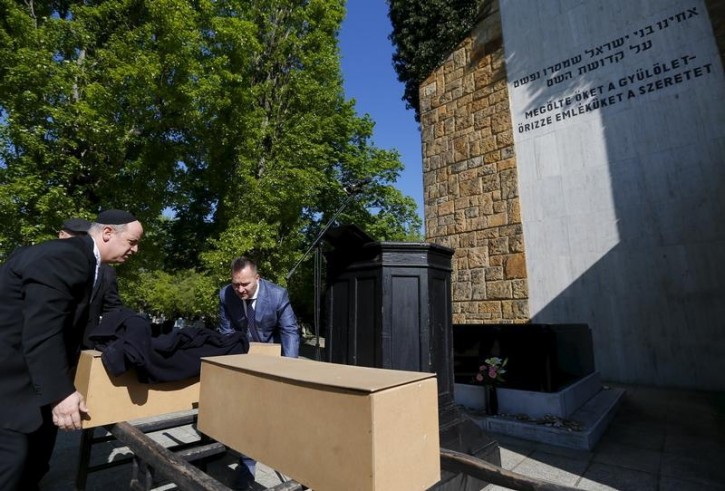 Budapest – Human remains found in 2011, including many believed to be of Jews shot on the banks of the Danube River near the end of World War II, were buried Friday in a Jewish cemetery in Budapest.
Budapest – Human remains found in 2011, including many believed to be of Jews shot on the banks of the Danube River near the end of World War II, were buried Friday in a Jewish cemetery in Budapest.
Subscribe to our Daily Roundup Email
Two wooden caskets containing hundreds of bone fragments were laid to rest according to Jewish customs in a ceremony attended by Christian clergy and government officials.
The remains were found during the renovation of Margit Bridge, which is located in an area in downtown Budapest where an estimated 3,600 mostly Hungarian Jews were executed by henchmen and allies of Hungary’s Arrow Cross, a pro-Nazi group which governed Hungary for a few months from late 1944.
“No similar series of murders took place in other large European cities. It is truly unique,” said historian Gabor Tabajdi. “Mass murders were taking place daily in the center of the city.”
Friday’s burial took place on the eve of Hungary’s Holocaust memorial day, which commemorates when Jews began to be placed in ghettos and camps ahead of their deportation to Nazi death camps. Over 420,000 Hungarian Jews were deported in less than 10 weeks and some 550,000 Hungarian Jews perished in the Holocaust.
Andras Heisler, president of the Federation of Hungarian Jewish Communities, said the burial was “the first and only case in 70 years” of bones believed to be of Hungarian Holocaust victims being found and buried.
“This burial is a very important moment in the processing of these events,” Heisler told The Associated Press. “I’d like if Hungarian Jews could break away from the position of victims they have been in for 70 years and move in the direction of progress and building the future.”

DNA testing found many bones had markers characteristic of Ashkenazi Jews.
Rabbi Baruch Oberlander said there were no religious objections to the Jewish burial even if it could not be fully ascertained that all the remains were from Jews. According to Jewish law, based on a biblical dictum, when the identity of someone to be buried is unknown, it should be decided based on the majority population.
“Ninety-five percent or more of the human remains found in the Danube from that era are from Jews, so there is no question that they should get a Jewish burial,” Oberlander said. “This is a first burial, not a reburial, because they were in water and water is not considered a burial place.”
Oberlander, whose father witnessed some of the killings by the Danube, said he had been contacted by several families whose relatives had been shot into the Danube hoping to compare their DNA samples with the remains.
During the ceremony at the Kozma Street Jewish Cemetery, Heisler recounted how his uncle, now 90 years old and living in Israel, survived his execution at the Danube when a bullet bounced off his forehead and another entered through his neck but exited without damaging vital organs.
Heisler described the era as “possibly the darkest in Hungarian history.”
“We are burying bones, but behind the remains there are people of flesh and blood,” Heisler said. “May the earth rest lightly on them.”


Why weren’t they buried in Israel?